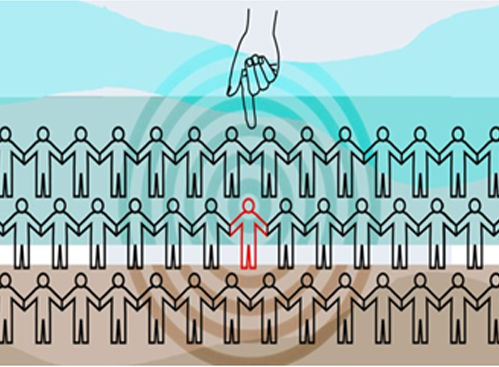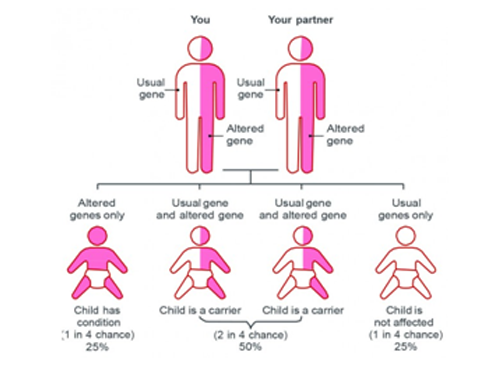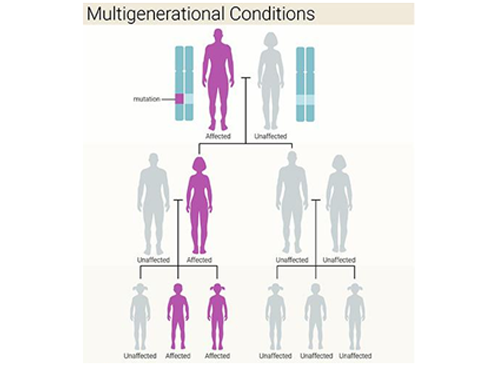Humans inherit 50% of genes from each of the parent, carried by haploid set of chromosomes. Genes are made of DNA (deoxyribonucleic acid), which contain instructions for cell functioning and the characteristics that make us unique.
Mutations can result from:
- Errors in DNA replication during cell division
- Exposure to mutagens such as UV radiation or carcinogenic chemicals or other environmental factors or viral infections.
- Smoking and radiation exposure
Germline mutations (that occur in eggs and sperms) can be passed on to offspring, while somatic mutations (that occur in body cells) are not passed on and genetic diagnosis can detect such disorders that may lead to diseases.
Identification of genetic disorders
If you have a family history of a genetic disorder, you may wish to consider genetic counselling to see if genetic testing is appropriate for you. Lab tests can typically show whether you have gene mutations responsible for that condition. In many cases, carrying the mutation does not always mean you’ll end up with it. Genetic counsellors can explain your risk and if there are steps you can take to protect your health.
If there’s a family history, DNA testing for genetic disorders can be an important part of starting a family.
-
Carrier testing:This blood test shows whether you or your partner carry a mutation linked to genetic disorders.This is recommended for everyone considering pregnancy, even if there is no family history.
-
Prenatal screening:This testing usually involves blood testing from a pregnant person that tells them how likely it is that a foetus could have a common chromosome condition.
-
Prenatal diagnostic testing:You can find out whether the developing foetus faces a higher risk for certain genetic disorders. Prenatal testing uses a sample of fluid from your uterus (amniocentesis).
-
New-born screening:This test uses a sample of your new-born baby’s blood and is performed on all babies born in Ohio. Detecting genetic disorders early in life can help your child receive timely care if needed.
About the Genetic Tests offered by Genome Foundation
FAQs
Cells are the basic building blocks of all living things. The human body is composed of trillions of cells. They provide structure for the body, take in nutrients from food, convert those nutrients into energy, and carry out specialized functions. Cells also contain the body’s hereditary material and can make copies of themselves.
In the nucleus of each cell, the DNA molecule is packed into thread-like structures called chromosomes. Each chromosome is made up of DNA tightly coiled many times around proteins called histones that support its structure.
Chromosomes are visible under a microscope at the time of cell division. Most of what researchers know about chromosomes was learned by observing chromosomes during cell division.
Each chromosome has a constriction point called the centromere, which divides the chromosome into two sections, or “arms.” The short arm of the chromosome is labelled the “p arm.” The long arm of the chromosome is labelled the “q arm.” The location of the centromere on each chromosome gives the chromosome its characteristic shape, and can be used to help describe the location of specific genes.
DNA, or deoxyribonucleic acid, is the hereditary material in humans and almost all other organisms. Nearly every cell in a person’s body has the same DNA. Most DNA is located in the cell nucleus (where it is called nuclear DNA), but a small amount of DNA can also be found in the mitochondria (where it is called mitochondrial DNA or mtDNA). Mitochondria are structures within cells that convert the energy from food into a form that cells can use.
The information in DNA is stored as a code made up of four chemical bases: adenine (A), guanine (G), cytosine (C), and thymine (T). Human DNA consists of about 3 billion bases, and more than 99 percent of those bases are the same in all people. The order, or sequence, of these bases determines the information available for building and maintaining an organism, similar to the way in which letters of the alphabet appear in a certain order to form words and sentences.
A gene is the basic physical and functional unit of heredity. Genes are made up of DNA. Some genes act as instructions to make molecules called proteins. However, many genes do not code for proteins. In humans, genes vary in size from a few hundred DNA bases to more than 2 million bases. An international research effort known as Human Genome Project, estimated that humans have between 20,000 and 25,000 genes.
A gene variant is a permanent change in the DNA sequence that makes up a gene. This type of genetic change used to be known as a gene mutation, but because changes in DNA do not always cause disease, it is thought that gene variant is a more accurate term. Variants can affect one or more DNA building blocks (nucleotides) in a gene.
Gene variants can be inherited from a parent or occur during a person’s lifetime:
- Inherited (or hereditary) variants are passed from parent to child and are present throughout a person’s life in virtually every cell in the body. These variants are also called germline variants because they are present in the parent’s egg or sperm cells, which are also called germ cells.
- Non-inherited variants occur at some time during a person’s life and are present only in certain cells, not in every cell in the body. Because non-inherited variants typically occur in somatic cells (cells other than sperm and egg cells), they are often referred to as somatic variants. These variants cannot be passed to the next generation. Non-inherited variants can be caused by environmental factors such as ultraviolet radiation from the sun or can occur if an error is made as DNA copies itself during cell division.
Some genetic changes are described as new (de novo) variants; these variants are recognized in a child but not in either parent. In some cases, the variant occurs in a parent’s egg or sperm cell but is not present in any of their other cells. In other cases, the variant occurs in the fertilized egg shortly after the egg and sperm cells unite. As the fertilized egg divides, each resulting cell in the growing embryo will have the variant. De novo variants are one explanation for genetic disorders in which an affected child has a variant in every cell in the body, but the parents do not, and there is no family history of the disorder.
Variants acquired during development can lead to a situation called mosaicism, in which a set of cells in the body has a different genetic makeup than others. In mosaicism, the genetic change is not present in a parent’s egg or sperm cells, or in the fertilized egg, but happens later, anytime from embryonic development through adulthood. As cells grow and divide, cells that arise from the cell with the altered gene will have the variant, while other cells will not. When a proportion of somatic cells have a gene variant and others do not, it is called somatic mosaicism. Depending on the variant and how many cells are affected, somatic mosaicism may or may not cause health problems. When a proportion of egg or sperm cells have a variant and others do not, it is called germline mosaicism. In this situation, an unaffected parent can pass a genetic condition to their child.
Most variants do not lead to development of disease, and those that do are uncommon in the general population. Some variants occur often enough in the population to be considered common genetic variation. Several such variants are responsible for differences between people such as eye color, hair color, and blood type. Although many of these common variations in the DNA have no negative effects on a person’s health, some may influence the risk of developing certain disorders.
A genetic predisposition (sometimes also called genetic susceptibility) is an increased likelihood of developing a particular disease based on a person’s genetic makeup. A genetic predisposition results from specific genetic variations that are often inherited from a parent. These genetic changes contribute to the development of a disease but do not directly cause it. Some people with a predisposing genetic variation will never get the disease while others will, even within the same family.




